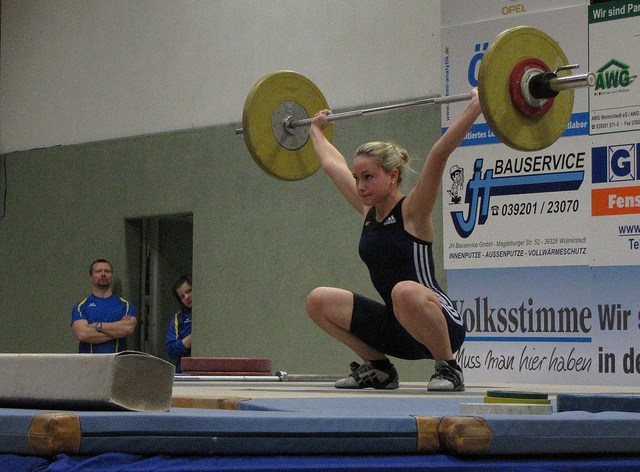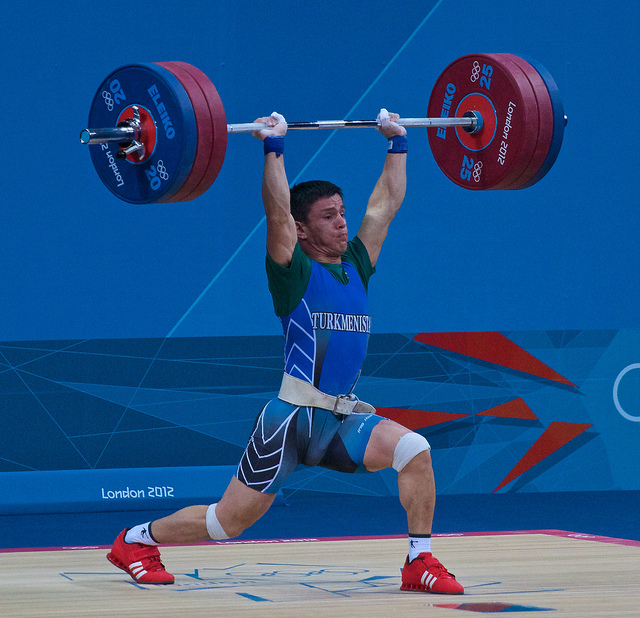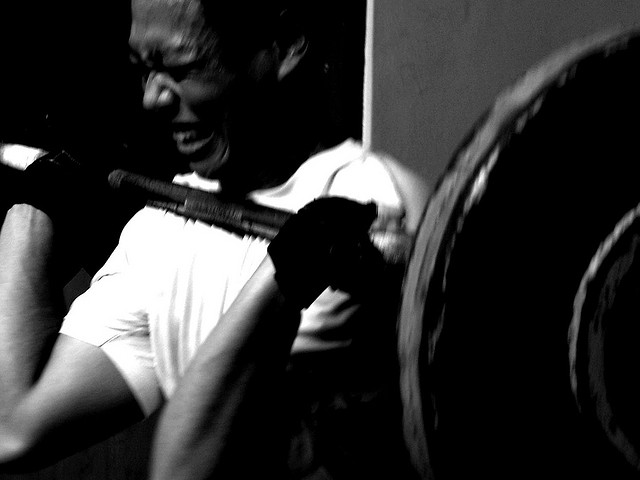A Quick Exposé About What You Need to Know BEFORE You Start Thinking About Learning The Clean and Jerk and Snatch Exercises

You know those old plastic, sand-filled weights that would only fit on a skinny, emasculated barbell? Yeah. That’s exactly what I used when I first started lifting weights at the ripe old age of eleven. One of our family babysitters was a hockey player and wrestler, and when he graduated high school and joined the military, he brought most of his weightlifting gear to our house for my brothers and I to use. He left a bench press, a couple barbells, and maybe 150 lbs of weight plates or so. Needless to say, I was PUMPED. Like, totally swole, yo.
And I made the most of this unexpected blessing, to say the least. Naturally, I gravitated towards bench pressing and curling. I mean, at 11 years old, the GUNZ are what’s most important, and the ladies do notice, right? I slapped on as much weight as my toothpick-arms could handle (not much). And there may have been one time that I got pinned under 50 lbs or so, and had to call for help. But that’s beside the point! Needless to say, I got hooked on this whole strength training thing, and a love for fitness, good movement, and athleticism has stayed with me ever since.
However, loving something doesn’t necessarily mean doing it right, and I made many mistakes in my early years, and still make my fair share of mistakes today if you can believe it. If I could go back and do it differently, I would. Maybe that would have saved me from that old deadlifting injury that happened awhile back.
Why Caution Is Necessary With The Olympic Lifts
I’ve spoken before about the dangers of weightlifting, but the truth is that weightlifting is a very safe activity when it is done properly. Unfortunately, proper weightlifting is usually the exception, not the norm. And it’s usually because people get into something that’s too much for them at once. They lift too much weight, for too many reps, or too frequently. They don’t understand the importance of technique, or how to apply that technique not just properly, but optimally. Or, they may know how to lift weights, but they understand little about the recovery process and the need for not just passive rest, but active recovery. So, naturally, we run into problems.
And this is why I wanted to write up an article to help you figure out when you’ll be ready to start learning the Olympic lifts. These exercises being the clean and jerk (aka C&J) and the snatch among many other variations. Now, these exercises are traditionally performed with a barbell as they are in the sport of Olympic weightlifting, but the movements can be performed with practically any strength training tool. You can perform both a C&J and a snatch with a barbell, dumbbell, kettlebell, clubbell, sandbag, medicine ball, stone, log, or practically anything else you can hold in your hands. The body mechanics are essentially the same, except for some key considerations in how you hold onto and maneuver the tool itself (e.g. different grip for a barbell versus a sandbag, different rack position for a kettlebell versus barbell, etc.).

Now, I consider the Olympic lifts to be high-skill, high-payoff exercises that also come with a higher risk of injury than most other weightlifting exercises. The risk is that not only are you performing a fairly technical lift, you’re also doing it rapidly and usually with significant load. In fact, the Olympic lifts are meant to be performed with more weight than the standard lifts. This is simply because the clean and jerk and snatch are both movements that are very efficient and allow you to lift significantly more weight overhead than a typical overhead press would because they are truly full body exercises. And it makes sense, too. Obviously, you can lift a lot more weight with your whole body than you can with just your arms and shoulders. And that’s really one of the main points of using them: to be able to apply more force, move more weight, and achieve a bigger strength and power adaptation than you could be simply lifting and pressing the weight with another, less efficient technique.
So, naturally, this is an upper level echelon in weightlifting and should only be considered by those whom have already mastered basic weightlifting already. That’s the first pre-qualification. And don’t tell me you’ve “mastered weightlifting” because you can bench press your bodyweight and curl the BIG dumbbells. If you haven’t mastered the squat, deadlift, and overhead press, among other things with your chosen training tool, then you’re just not ready for the Olympic lifts. And if you’re wondering what kind of numbers that looks like, look it up. And hey, knowing that you’re just not ready would be good news for you because you’d actually get more overall benefit from the rudimentary exercises than you would from jumping ahead to the technical stuff. In fact, you could spend a lifetime on these basics, as many lifters do, and be just fine. Apart from weightlifting athletes, nobody truly needs the Olympic lifts, but those that use them properly will certainly receive great fitness and strength/conditioning benefit from their use.
And talk about a practical set of movement skills! Who wouldn’t want to learn how to lift something from the ground up over their head in the most efficient manner possible? It’s an important skill, and a lot of people get themselves into trouble when lifting something overhead in an INefficient manner.
The Necessity Of Proper Instruction
Back when I was in college, my school had a strength and conditioning coach on staff who would offer free training to those students who were interested. I happened to be at the gym on a particularly dead day, and after seeing me rack a barbell, this coach came over and offered to teach me something new. We spent the next hour working on the barbell power snatch, which was completely foreign to me at the time. To say it was a new experience would be an understatement. The word “awkward” comes to mind. But after an hour of instruction, I had the gist of it and knew what I had to focus on to improve my technique. And over the next few months, we worked on the power clean, jerk, clean and jerk, and the snatch. Looking back, I’m really grateful for the experience. And having gone through it this way, I understand the importance of having a coach to learn the Olympic lifts.
Now, it’s true that I have often been one to recommend that people take the bull by the horns and teach themselves how to exercise, and I’ve publicly admonished this practice many times over the years. I think that in the vast majority of cases for the vast majority of people, most folks can learn how to exercise safely and effectively without a professional trainer, and the intrinsic rewards for going this route are huge.*
Now, that’s all well and good, but when it comes to the Olympic lifts, I make a vehement exception to my normal recommendation. The Olympic lifts, especially when performed with a barbell (and consequently, under heavy, near-maximal loads), should always be learned from a competent instructor – not from a Youtube video, not from a book, not from a DVD, not even from online coaching. The Olympic lifts merit live instruction from a professional. It’s just not wise to try and learn these exercises alone because a mistake is more likely to happen and if it does, it’s more likely to do more harm. So, the other way to know whether or not you’re ready to learn the Olympic lifts, is whether or not you’re willing and able to find a coach or attend a workshop. Given that these are higher-risk exercises that aren’t really necessary for the vast majority of people, I don’t see this as a problem. If you really want or need to learn them, then this should be a non-issue.
Other Considerations
The other thing you’ll need to learn the Olympic lifts is time (and patience). So, if you’re one of those people who has “no time,” and are looking for the shortest possible workout solutions on planet Earth, it’s probably a good idea to hold off on the O-lifts for now. Learning the Olympic lifts takes time and patience. They’re technical. In the beginning, it’ll be a lot more practice than training. But you’ll still need plenty of time for recovery, too. Sure, you can learn how to perform each of the lifts in about an hour, and with a good coach, much less time than that. But it will take several weeks, if not months, to perfect your technique.
And it should go without saying, that you should only start learning the Olympic lifts if you’re free from pain, injuries, and otherwise healthy. If you’ve got constant lower back pain, recurring knee pain, or an old shoulder injury that acts up from time to time, then it’s not a good time to learn the Olympic lifts just yet. Get those issues straightened out first. And if you’ve got a debilitating structural condition that’s with you for life, then you might just want to pass on the Olympic lifts entirely. And again, nothing wrong with that at all. There are plenty of great exercises out there. It’s all about finding what’s best for you.
The Bottom Line
So, when is someone truly ready to learn the Olympic lifts? Well, it depends – on a lot, actually. In a discussion I had with Strength Coach, Dan John (click here for the interview), he noted that he doesn’t usually teach the olympic lifts to professional athletes, and especially not in the playing season. Instead, he’ll teach the O-lifts to 8th and 9th graders. And in the case of athletes, he’ll teach them when they’ve got the basics down and have time to focus on higher-skill exercises (ie the WAY off-season). That’s not bad advice, and Dan John would know.
So, to recap, you’re ready to learn the Olympic lifts if you’re healthy, free from injury, have mastered basic weightlifting, can get live instruction, and have ample time in your schedule to learn and practice the lifts for several weeks or months. If that’s you, and you want to learn the Olympic lifts, then go for it. You’ll be glad you did.
Oh, and one last thing. Don’t be this guy…

If you found this article helpful, please share it with your friends and tweeps:
.jpg)
![]()
CST Coach, CST-KS
Health-First Fitness Coach
P.S. If you liked this post, then please signup for the newsletter, or follow me on Facebook or Twitter for daily updates and other interesting info.
P.P.S. Photo Credit: http://www.flickr.com/photos/fchmksfkcb/, http://www.flickr.com/photos/rowanbank/, http://www.flickr.com/photos/giovannijl-s_photohut/
*But of course, learning how to exercise on your own takes more time and should be done progressively – baby steps – to minimize the risk of problems and see potential problems coming well in advance. That said, having a trainer or coach is certainly the best option and will rapidly accelerate your learning and results. If you can afford one, get one.
John – love your stuff and site, but I’m going to respectfully disagree with this article. I have an advanced degree in kinesiology and coaching certification in Canada in olympic weightlifting.
I do agree that the person needs to have certain basic motor skills and movement patterns prior to learning the lifts. If you can’t support a weight overhead or rack it on your shoulders you can’t olympic lift. But given that you can, the olympic lifts can be performed by almost anyone. While it is certainly better to have a qualified coach, it isn’t essential.
What is essential?
1. Learn to front squat and power snatch first. Be comfortable in a front rack position and with the bar overhead.
2. Learn how to miss and dump the bar. Even if you don’t have bumper plates it is better to dump the bar and ruin the floor than injure yourself. Dumping the bar successfully means pushing yourself away from the bar (which can be tricky when you lose a snatch behind, but is doable, even without coaching).
3. Don’t lift maximal weights for the first 12 weeks of training or until your technique is grooved in. This is a big area of disagreement I have with John – sure, the olympic lifts are designed for maximal weights, but you don’t START that way! Olympic lifting is safer than most sport activities – assuming you can keep the ego in check.
I also have to agree with Dan John. The goal for a professional athlete is to increase some physical capacity (speed, strength, power, endurance) within a framework of general movement skills. Why would you teach the olympic lifts to a professional athlete in season when a simpler movement would suffice? What is it Dan says? “Keep the goal the goal.”
But for the typical person interested in weightlifting – I don’t think that getting ‘decent’ at the olympic lifts is that tough, even without a coach. Now, getting elite – well, different thing entirely.
All good points, Hobbes – thank you. And while I will stand my ground and say that it’s BEST to have a coach when learning these lifts since they do run a little higher on the risk spectrum, that’s not to say people can’t learn the O-lifts themselves. And obviously, many people do. I just don’t recommend it.
And I really hope I didn’t convey that I thought complete beginners should start with near-maximal loads. That would be a very bad idea, indeed. I started with an empty barbell.
Hey John – as usual when I start thinking deeper on this I agree with you more and more. Better to have a coach. Oh, yeah! Also, I think your point (well, one of them anyhow) was there are alternatives for the classic O-lifts that are easier to learn and just as effective in developing necessary qualities. I agree with that 100% as well.
I went from the Canadian Master powerlifting record holder in squat and total to a stick. Humbling. It was really good for me…
I hear ya! I’ve never had an interest in powerlifting or maximal strength development, in general, but I went from an (almost) 2x bodyweight deadlift to not being able to bend over for awhile. Humbling, indeed. And an instrumental experience in my professional development.